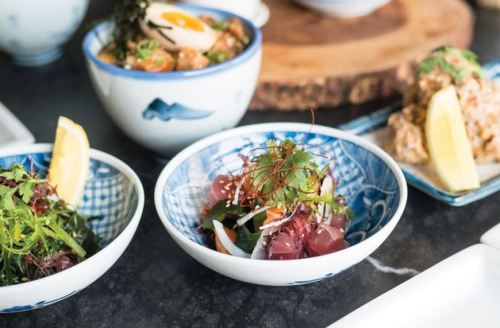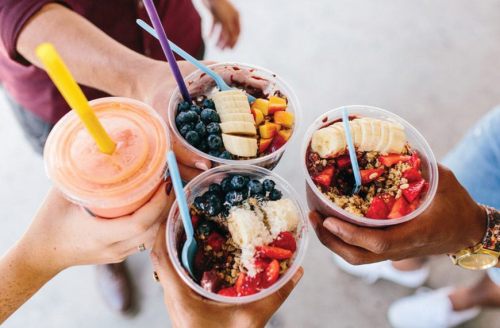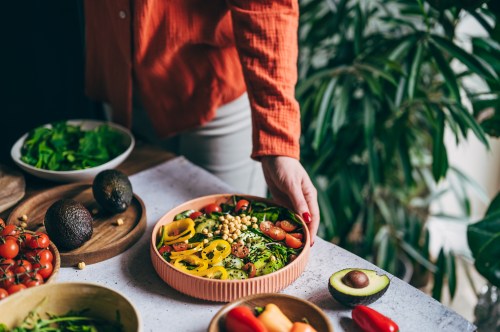Our editors independently select these products. Making a purchase through our links may earn Well+Good a commission
This is what “clean eating” looks like around the world
The definition of healthy food is different everywhere. Here, nutrition experts from all corners of the globe share what "clean eating" means in their country—from ingredients to food philosophy.

Picture-perfect smoothie bowls, hearty salads, wild-caught salmon with loads of veggies—all of these are hallmarks of a typically “clean” American diet. But in other parts of the world, there’s a lot more to healthy eating than simply filling your farmers market basket with wholesome foods.
Take Moroccan cuisine, for example. Sure, it’s loaded with healing spices, like ginger, turmeric, cinnamon, and cumin. And in any given dish, you’ll find tons of nutrient-dense ingredients, including chickpeas, fava beans, carrots, and beetroot. But prepping a Moroccan tagine or stew—a process that takes hours—is also an exercise in patience and mindfulness. During this slow-cooking process, the meat cooks gradually and spices blend richly, allowing you to truly taste every ingredient in your finished dish. (A vastly different experience from picking up a takeout salad and scarfing it down at your desk, no?)
So if you’re feeling uninspired by your usual recipe rotation, consider bringing some global flavors—and perspectives on what’s truly nourishing—into your kitchen. Here, food pros from around the world share what healthy eating means to them. As you’ll soon learn, a good-for-you meal outside of the US isn’t just a means to a strong gut or a sharp mind—it’s often an act of self-care, too. Santé!
Keep reading for the basics of clean eating in 4 different countries.

Japan
In Japanese culture, healthy eating is centered around disease prevention, says Candice Kumai, author of Kintsugi Wellness and host of the Wabi Sabi podcast. “The primary focus of the [Japanese] diet is to eat delicious, real food and to nourish the body,” explains the Well+Good Council member. And while you could argue the same is true in American wellness culture, the Japanese way of eating is about keeping things simple. (Translation: No 15-ingredient adaptogenic smoothies here.)
Kumai, who traveled to Japan to write her latest book, says that devotional Japanese monks practice Shōjin Ryōri, a type of plant-based cuisine. “In Japanese culture, we don’t really focus on ‘health’ foods but rather fermented foods,” Kumai says. According to her, dishes like miso eggplant, tsukemono (Japanese pickles), and fresh homemade tofu dominate many “clean” Japanese tables. Most menus also include vegetable-based broths made with kombu (Japanese seaweed), gohan (cooked rice), and rice vinegar. And Kumai says no meal is complete without a cup of sencha (steamed Japanese green tea) and seasonal fruit, such as persimmons and fresh melon.
Presentation also plays a big role during meal times. “Eat with smaller, colorful plates (moritsuke) as the Japanese do,” Kumai says. The benefits to this go beyond aesthetics: Studies have actually shown that eating your meals with a smaller plate can help you practice portion control, and using red plates can help tame your appetite.

Brazil
Contrary to what you may think given all the supermodels that come out of Brazil, the country’s approach to healthy eating isn’t focused on calorie counting. Instead, its impressive national dietary guidelines encourage eating more whole foods; limiting processed foods; using sugar, fat, and salt wisely; and making eating a social experience. (As if you needed another reason to put more girls’ nights out in your calendar.)
There’s also a lot less carb-phobia in Brazil, says Brazilian Dietitian founder Girlene Coughlin, RDN. Old-fashioned oatmeal with berries is considered a good breakfast, while quinoa—which happens to be an ancient South American grain—is a clean dinner staple. (To eat it the healthy Brazilian way, mix it with cucumbers, red onion, olive oil, and avocado. )“Quinoa has all the amino acids found in meat and eggs,” Coughlin points out.
When Brazilian people want to eat healthier, they usually swap extra veggies into their diets, like salads with nuts and seeds. “They’ll add two servings of vegetables instead of two servings of starches,” says Coughlin.
Brazil is also known as the birthplace of açai bowls. But with the abundance of tropical fruits found in the region, all types of smoothies and juices are hot with healthy locals. “People love smoothies in Brazil,” Coughlin says. “I recommend a green smoothie to obtain the nutrients and fiber from vegetables.”

Bulgaria
Nedi Varbanova, founder of Healthy with Nedi and a certified culinary nutritionist, says that home cooking equates to health in her native Bulgaria—and the country’s residents don’t shy away from meat or dairy, like many people do in the US. “It was easy to eat clean while growing up in Bulgaria,” she says. “My mom always prepared meals that consisted of lots of Greek salads, spinach or chicken soups, stuffed peppers with meat, and roast chicken with veggies.”
Some of the most common foods you’ll find in Bulgarian cuisine include bread and phyllo dough pastries like baklava—yes, they’re considered healthy in those parts. “Bulgarian people eat them daily,” Varbanova says.
Because Bulgaria borders many Mediterranean countries, its dishes are largely inspired by the foods in the region—including Varbanova’s personal favorite. “Mishmash consists of scrambled eggs, roasted peppers, grated tomatoes, onion and feta cheese,” the co-author of the F-Factor cookbook says. “It’s similar to shakshuka. I highly recommend it!”

India
You might say India is the O.G. destination for wellness-inspired eating. It’s where the Ayurvedic diet was developed some 5,000 years ago as a way to help people live better lifestyles and approach their health holistically.
According to Ayurveda, everyone has a distinct dosha—AKA body type—and this is what determines your ideal diet. “There’s no good or bad food in itself—it depends on one’s individual needs at [any given] time,” nutritional consultant Divya Alter told Well+Good. “Some people are more airy (vata), some are more fiery (pitta), and others more earthy (kapha). This is why one food or herb may be good or balancing for one, but toxic and aggravating for another.”
In general, vata doshas should eat warm, grounding things; pitta doshas should stay away from ultra-spicy foods; and kapha doshas thrive on light, dry meals without a lot of oil. And then, there are certain recipes that are healthy for all doshas—like this turmeric lemonade, which translates to summer perfection no matter where you are in the world.
Want to experience international health food firsthand? Here are 9 wellness vacations you can book for under a grand, and tips for living (and eating) like a local when you’re on the road.
Sign Up for Our Daily Newsletter
Get all the latest in wellness, trends, food, fitness, beauty, and more delivered right to your inbox.
Got it, you've been added to our email list.










